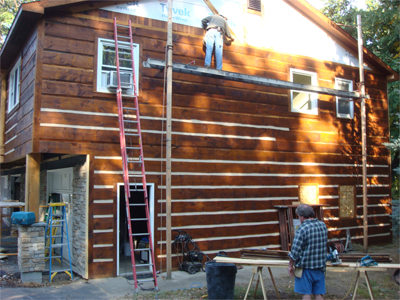Log Home Chinking

Chinking Your Log Home: Essential for Comfort and Durability
Ever wondered how log homes stay so cozy? Well, a big part of that magic is something called chinking. Imagine it as the special glue that keeps the logs together, making sure your home stays warm and keeps bugs outside where they belong.
There are many different styles of log homes but not all require chinking. However, there are many dovetail style and larger round log homes that do use chinking as a sealant.
- Chinking is the final step in sealing this style of home and can be decorative as well as practical in its use.
- The difference between whether you use chinking or caulking, outside of there chemical makeup, is based on the size of the joint you are sealing and if you are wanting to see the product as part of the esthetics of the home.
- Caulking is a seal and is meant in most cases to blend in or be hidden when used.
- Chinking as a seal can help you conserve energy and protect your home from infiltration of air, water and insects.
- The color of the chinking can determine the look of the home by either being a bright white which will create a big contrast to the logs or a tan that will be a much smaller contrast or many shades in between.
- Modern latex chinking is very long lasting and low maintenance. When applied properly it can pay off many times over in the comfort, preservation, and resale value of your home.
 Log Building Maintenance and Restoration will be happy to help you with your chinking needs, whether it is being done for the first time or because of settling and exposure to the elements.
Log Building Maintenance and Restoration will be happy to help you with your chinking needs, whether it is being done for the first time or because of settling and exposure to the elements.
When our skilled team takes on the job, we use a proven mix of log cabin mortar and high-quality caulking to fill those gaps, ensuring your home is properly sealed. This isn't just for looks; it really strengthens your home's ability to stand up against wind and rain and even helps cut down on those pesky heating bills by stopping air leaks.
Our materials have evolved significantly, blending tradition with modern innovation. Today, options include synthetic, which are known for their durability and ability to seamlessly integrate with the original logs.
Maintenance and the right materials are key.
Finding the Perfect Mix
'A home's soul is in its details. Chinking is more than just filling gaps; it's preserving history while embracing the future,' says a local expert. This captures our philosophy perfectly. You're not just maintaining a building; you're caring for a piece of tradition, all while making sure it's as energy-efficient and ready to face whatever the weather throws at it.
Professional Chinking Services
Our services extend beyond aesthetics, covering repair, restoration, and maintenance, crucial for maintaining the home's energy efficiency and structural integrity. We use the highest-quality materials and meticulous processes to ensure durability and performance.
Chinking is vital for energy efficiency. It creates a tight seal that keeps homes comfortable across seasons, reduces heating and cooling costs, and protects it from the elements.
Regular chinking maintenance is vital to preserving your home's rustic charm and enhances your home's appearance.
Chinking Materials
We employ a variety of materials in our chinking processes, each offering distinct benefits and challenges. Historically, chinking started with natural materials like mud and moss, providing basic insulation and protection.
Technological advances have improved chinking materials, including synthetic options like acrylic and polyurethane. These modern materials excel in sealing gaps and guarantee durability, flexibility, and resistance to weather elements.
Choosing chinking materials becomes a balance between aesthetic preference, environmental considerations, and long-term performance for homeowners.
These materials are not just about maintaining a structure; it's about preserving a lifestyle and embracing a community that values tradition, innovation, and the natural beauty of log homes. Talk with our experienced professionals to decide on the best materials for your project.
Chinking FAQs: Ensuring Your Log Home's Longevity
How long does chinking last?
With proper maintenance and high-quality materials, chinking can last 20-30 years, maintaining your home's warmth and inviting atmosphere.
It's crucial to choose high-quality chinking materials and adhere to a meticulous application process. By doing so, you will improve the energy efficiency of your log home and foster an environment where memories are made and cherished.
Do All Log Homes Require Chinking?
There are many different styles of log homes but not all require chinking. However, there are many dovetail style and larger round log homes that do use chinking as a sealant.
- Chinking is the final step in sealing this style of home and can be decorative as well as practical in its use.
- The difference between whether you use chinking or caulking, outside of their chemical makeup, is based on the size of the joint you are sealing and if you are wanting to see the product as part of the aesthetics of the home.
- Caulking is a seal and is meant in most cases to blend in or be hidden when used.
- Chinking as a seal can help you conserve energy and protect your home from infiltration of air, water and insects.
- Modern latex chinking is very long lasting and low maintenance. When applied properly it can pay off many times over in the comfort, preservation, and resale value of your home.
Do you seal logs before chinking?
Sealing logs is an essential step in the process to ensure a strong and lasting bond. It is done before chinking to create a strong bond and protection against moisture.
What is the best color for chinking?
The best color for chinking is not a one-size-fits-all answer. It varies widely based on the unique character of your log home, its setting, and your personal taste. The ideal color and materials offer flexibility, durability, and compatibility with log movements.
The color of the chinking can determine the look of the home by either being a bright white which will create a big contrast to the logs or a tan that will be a much smaller contrast or many shades in between.
Many homeowners opt for a color that closely matches their logs, creating a seamless and harmonious look that feels like it belongs. Others prefer a contrasting color to highlight the architectural details and craftsmanship of the log structure. Consulting with professionals can help you envision how different colors will compliment your home.
What is the best material for chinking?
In our expertise, the best chinking material enhances your log home's beauty and structure. Synthetic options, such as acrylic and latex-based compounds, have emerged as leaders in this domain. These materials offer flexibility, enduring durability, and excellent adhesion to log surfaces.
 A few of the popular brands are:
A few of the popular brands are:
- Perma-Chink
- Log Jam Chinking
- Sashco
Additionally, they are environmentally friendly and can accommodate the natural expansion and contraction of the logs, ensuring a tight seal.
Log Building Maintenance and Restoration will be happy to help you with your chinking needs, whether it is being done for the first time or because of settling and exposure to the elements. Contact our team today!
